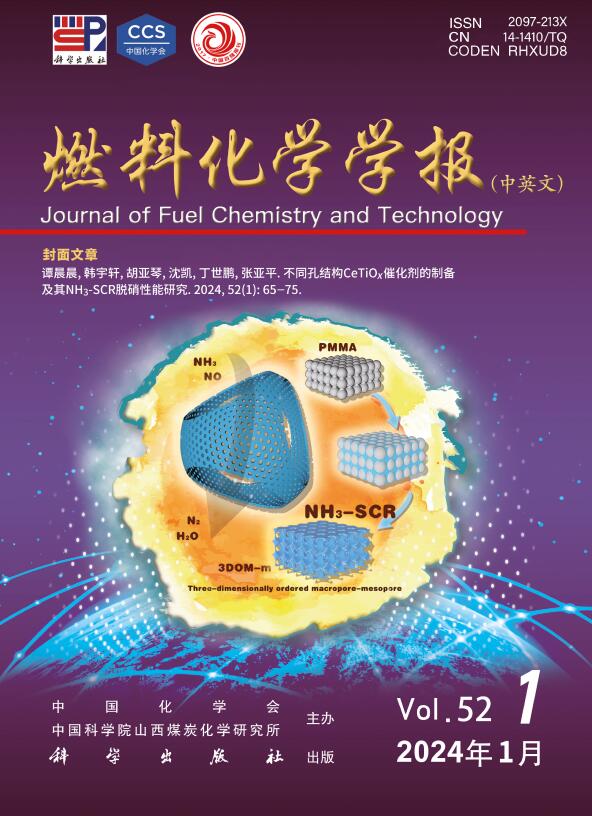Study on the improvement of ultra-low temperature performance and adsorption mechanism of Mn and Ce based denitrification catalysts by “NO2 SCR”
Q3 Energy
引用次数: 0
Abstract
The catalysts supported by Mn7Fe4Ce9Ox/AlOx and Mn3Fe1Ce6Ox/AlOx prepared by co-precipitation method were first evaluated by standard SCR mechanism reaction under 7777 h–1 intake condition. The catalytic activity of the two catalysts was only about 10% at 60 °C. Then, the concentration ratio of NO2/NOx in intake air was increased under the same conditions, and the concentration ratio of NO2/NOx in intake air was 0, 14.3%, 28.6%, 42.8%, 57%, 71.4%, 85.7% and 100%. The results show that the denitrification efficiency of Mn3Fe1Ce6Ox/AlOx catalyst can be 64% at 60 °C, which is about 58% higher than that of the first evaluation. Experimental and theoretical calculations show that Mn3Fe1Ce6Ox/AlOx catalyst has larger specific surface area and stronger adsorption and activation of NO2, which improves the efficiency of NO2 fast SCR mechanism reaction. At the same time, the in-situ infrared test found that the adsorption mode of Mn3Fe1Ce6Ox/AlOx catalyst changed significantly when the concentration ratio of NO2/NOx increased, and the E-R and L-H mechanism mainly adsorbed by NH3 changed to the E-R and L-H mechanism mainly adsorbed by NO2. The change of adsorption mechanism may be the key factor to improve the performance of catalyst at ultra-low temperature. This work provides a promising strategy for exploring efficient and economical denitrification of NH3-SCR, as well as experience for ultra-low temperature flue gas treatment and guidance for new flue gas treatment processes.
“NO2 SCR”改善锰、铈基脱硝催化剂超低温性能及吸附机理的研究
采用共沉淀法制备的Mn7Fe4Ce9Ox/AlOx和Mn3Fe1Ce6Ox/AlOx负载催化剂,在7777 h-1进气条件下,通过标准SCR机理反应对催化剂进行了评价。两种催化剂在60℃时的催化活性仅为10%左右。然后,在相同条件下提高进气NO2/NOx浓度比,进气NO2/NOx浓度比分别为0、14.3%、28.6%、42.8%、57%、71.4%、85.7%和100%。结果表明,在60℃条件下,Mn3Fe1Ce6Ox/AlOx催化剂的脱硝效率可达64%,比第一次评价时提高约58%。实验和理论计算表明,Mn3Fe1Ce6Ox/AlOx催化剂具有更大的比表面积,对NO2的吸附和活化能力更强,提高了NO2快速SCR机理反应的效率。同时,原位红外测试发现,随着NO2/NOx浓度比的增加,Mn3Fe1Ce6Ox/AlOx催化剂的吸附方式发生了显著变化,由以NH3为主吸附的E-R和L-H机制转变为以NO2为主吸附的E-R和L-H机制。吸附机理的改变可能是提高催化剂超低温性能的关键因素。本研究为探索NH3-SCR高效经济脱硝提供了有前景的策略,也为超低温烟气处理提供了经验,并为新的烟气处理工艺提供了指导。
本文章由计算机程序翻译,如有差异,请以英文原文为准。
求助全文
约1分钟内获得全文
求助全文
来源期刊

燃料化学学报
Chemical Engineering-Chemical Engineering (all)
CiteScore
2.80
自引率
0.00%
发文量
5825
期刊介绍:
Journal of Fuel Chemistry and Technology (Ranliao Huaxue Xuebao) is a Chinese Academy of Sciences(CAS) journal started in 1956, sponsored by the Chinese Chemical Society and the Institute of Coal Chemistry, Chinese Academy of Sciences(CAS). The journal is published bimonthly by Science Press in China and widely distributed in about 20 countries. Journal of Fuel Chemistry and Technology publishes reports of both basic and applied research in the chemistry and chemical engineering of many energy sources, including that involved in the nature, processing and utilization of coal, petroleum, oil shale, natural gas, biomass and synfuels, as well as related subjects of increasing interest such as C1 chemistry, pollutions control and new catalytic materials. Types of publications include original research articles, short communications, research notes and reviews. Both domestic and international contributors are welcome. Manuscripts written in Chinese or English will be accepted. Additional English titles, abstracts and key words should be included in Chinese manuscripts. All manuscripts are subject to critical review by the editorial committee, which is composed of about 10 foreign and 50 Chinese experts in fuel science. Journal of Fuel Chemistry and Technology has been a source of primary research work in fuel chemistry as a Chinese core scientific periodical.
 求助内容:
求助内容: 应助结果提醒方式:
应助结果提醒方式:


